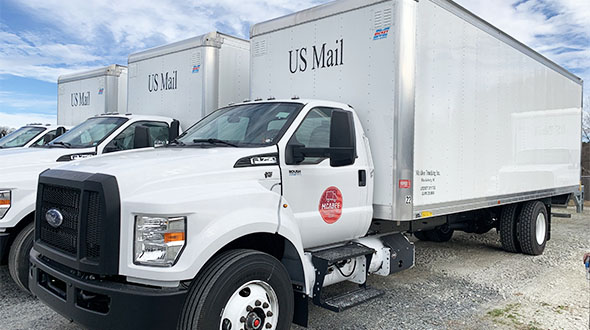Propane autogas provides relief for fleet vehicles
When fuel prices rise, the phone usually rings.
That’s when Steve Whaley listens to the voice on the other end of the call inquiring about ways to lower vehicle fuel costs.
“There’s always a renewed interest from folks who are trying to keep vehicles on the road within a budget that had already been set for them,” he says. “They’re scrambling for relief, so they go back through their Rolodex [and remember], ‘He told me he can save me money on fuel.’”
Whaley recalls receiving those types of calls from fleet operators when he worked for vehicle solutions providers that performed aftermarket autogas vehicle conversions.
Now, as the autogas business development director for the Propane Education & Research Council (PERC), Whaley says PERC also receives an uptick in calls amid rising fuel prices. Many are from consumers looking to run their vehicles “on something other than gasoline.”

McAbee Trucking, a freight shipping and trucking company based in Blacksburg, South Carolina, operates Ford F-750 delivery trucks fueled by propane autogas. The vehicles are used for contracted parcel delivery routes. (Photo courtesy of Roush CleanTech)
U.S. average gasoline and diesel prices, stoked by Russia’s invasion of Ukraine, set record highs in March. Gasoline reached $4.33 a gallon on March 11, while diesel prices topped $5, according to AAA.
“People in the United States are not used to these kinds of gasoline and diesel prices that, quite frankly, the rest of the world has had to deal with for a long time,” he says, noting how 26 million vehicles worldwide are operating on propane due in part to high fuel prices in their respective countries and LPG as an easy fit.
No matter the type of call, Whaley finds an opportunity to promote the benefits of propane autogas, and that conversation becomes even easier when the gap widens between conventional fuels and autogas.
The price of autogas is often about 30 percent less than that of gasoline, according to Alliance AutoGas, which tracks prices by region on its website. The average prices for the week of March 25, based on national averages, ranged between $2.24 and $2.40 per gallon.
“We talk about replacing vehicles with new OEM systems, but we also have EPA-certified conversion systems for fleet vehicles,” Whaley says.
PERC’s work in the on-road vehicle segment centers on medium-duty commercial fleets and school buses.
Propane already powers about 70,000 on-road vehicles and 22,000 school buses in the U.S., the council says, and federal infrastructure legislation signed into law late last year could spur growth in the market. Propane-fueled vehicles and refueling infrastructure are eligible to compete for billions of dollars in funding through the Infrastructure Investment and Jobs Act.
Federal support comes at a time when fleets are facing a challenging environment – not only due to rising fuel prices but also breakdowns in the supply chain that have diminished new vehicle availability. Therefore, aftermarket conversion options will give fleets immediate relief, Whaley says.
“That will be the biggest push because they don’t have to wait to get a new vehicle,” he says. “They can get vehicles converted very quickly and running on propane. That’s where most of the interest is – existing gasoline vehicles getting a new heart.”
Since his hire by PERC in 2020, Whaley has prioritized helping propane marketers transition their own fleets to autogas. Rising fuel prices give him another point of emphasis with this propane industry segment. He cites the benefits of marketers converting their service trucks to autogas and realizing a return on investment in a matter of months.
Whaley references a five-year PERC study (2015-20) that compared Superior Plus Propane’s use of Ford F-550 service trucks operating on autogas and diesel. Results showed the autogas vehicles having bottom-line benefits over their diesel counterparts, specifically with maintenance and fuel costs.
“Based on fuel costs for those five years, it was 29 cents-per-mile savings” with autogas, Whaley says.
“But now, conventional fuel has gone way up since those days,” he adds. “Folks ought to be capitalizing on that.”
High gasoline, diesel prices present opportunities
LP Gas asked leaders in the autogas industry the following question. Their answers are printed here, edited for length and clarity.
Q:What’s your message to fleet operators inside and outside the propane industry in light of record-high gasoline and diesel prices?

Weidie
“Propane costs less than half versus gasoline and diesel for propane marketer vehicles – and 40 percent less for the commercial vehicle customers that our industry currently sells autogas to. The performance is the same, so why would anyone volunteer to pay more for fuel?” – Stuart Weidie, CEO, Blossman Gas; president, Alliance AutoGas

Johnson
“Autogas provides a significant reduction in fuel costs, consistently averaging 30 percent lower than gasoline and diesel, and that gap is widening. … Integrating autogas into a fleet [outside the propane industry] is not as daunting as some might think. There are autogas professionals who can help see a project through from start to finish, and who will ensure your ROI meets or exceeds its initial goals. From funding the project to training the drivers, someone is there each step of the way. … Making the investment in autogas for [a propane marketer’s] fleet will pay off. You will see lower annual fuel costs, a lower cost per mile, and prove to your customers that propane is an energy source for today and tomorrow. … Like I always say, ‘What is your fleet waiting for?’” – Jessica Johnson, national accounts coordinator, ThompsonGas

Mouw
“Propane autogas offers an unparalleled combination of cost savings and emissions reductions. We are a country that is rich in this energy resource. … Roush CleanTech is bullish on the future of propane, even before the current spike in gas and diesel prices. With more than 30,000 propane-fueled commercial trucks and school buses on the road that have traveled over 2 billion miles, we are confident propane and renewable propane will have a significant voice in the future of transportation.” – Todd Mouw, executive vice president, Roush CleanTech

Venezio
“Propane fuel suppliers should use their own domestic fuel in their vehicles, utilizing systems from proven, longtime industry manufacturers to keep their fleets on the road without interruption at the lowest cost per mile and support a U.S. industry. … Fleet operators outside the propane industry could utilize propane, the abundant U.S. fuel with the lowest cost per mile in the U.S. transportation sector; avoid fuel supply disruptions and often budget their fuel costs over time and not be susceptible to huge gasoline and diesel fuel-cost increases; [and] meet their fleet sustainability and emission-reduction objectives. … Keep America moving forward utilizing lower-cost U.S. domestic fuel.” – Albert Venezio, chairman, Icom North America
















